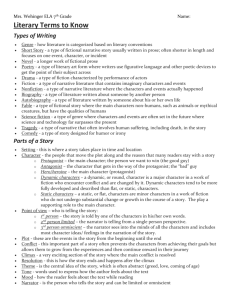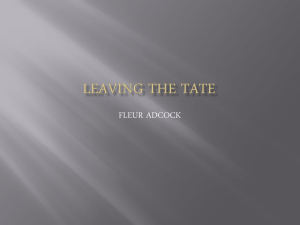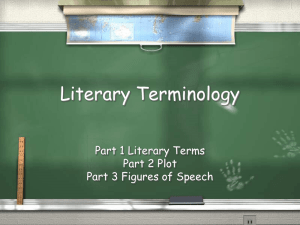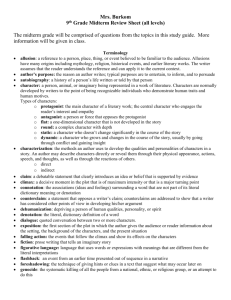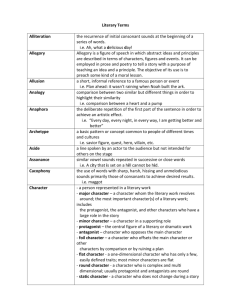Allegory: is a figurative mode of representation conveying a
advertisement
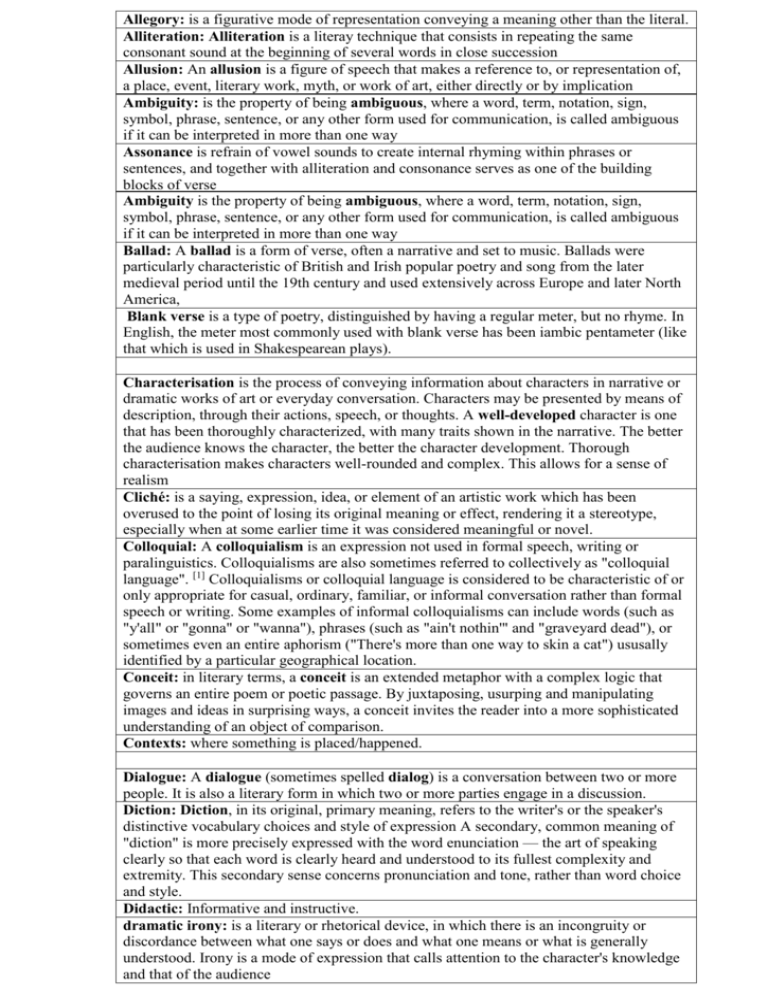
Allegory: is a figurative mode of representation conveying a meaning other than the literal. Alliteration: Alliteration is a literay technique that consists in repeating the same consonant sound at the beginning of several words in close succession Allusion: An allusion is a figure of speech that makes a reference to, or representation of, a place, event, literary work, myth, or work of art, either directly or by implication Ambiguity: is the property of being ambiguous, where a word, term, notation, sign, symbol, phrase, sentence, or any other form used for communication, is called ambiguous if it can be interpreted in more than one way Assonance is refrain of vowel sounds to create internal rhyming within phrases or sentences, and together with alliteration and consonance serves as one of the building blocks of verse Ambiguity is the property of being ambiguous, where a word, term, notation, sign, symbol, phrase, sentence, or any other form used for communication, is called ambiguous if it can be interpreted in more than one way Ballad: A ballad is a form of verse, often a narrative and set to music. Ballads were particularly characteristic of British and Irish popular poetry and song from the later medieval period until the 19th century and used extensively across Europe and later North America, Blank verse is a type of poetry, distinguished by having a regular meter, but no rhyme. In English, the meter most commonly used with blank verse has been iambic pentameter (like that which is used in Shakespearean plays). Characterisation is the process of conveying information about characters in narrative or dramatic works of art or everyday conversation. Characters may be presented by means of description, through their actions, speech, or thoughts. A well-developed character is one that has been thoroughly characterized, with many traits shown in the narrative. The better the audience knows the character, the better the character development. Thorough characterisation makes characters well-rounded and complex. This allows for a sense of realism Cliché: is a saying, expression, idea, or element of an artistic work which has been overused to the point of losing its original meaning or effect, rendering it a stereotype, especially when at some earlier time it was considered meaningful or novel. Colloquial: A colloquialism is an expression not used in formal speech, writing or paralinguistics. Colloquialisms are also sometimes referred to collectively as "colloquial language". [1] Colloquialisms or colloquial language is considered to be characteristic of or only appropriate for casual, ordinary, familiar, or informal conversation rather than formal speech or writing. Some examples of informal colloquialisms can include words (such as "y'all" or "gonna" or "wanna"), phrases (such as "ain't nothin'" and "graveyard dead"), or sometimes even an entire aphorism ("There's more than one way to skin a cat") ususally identified by a particular geographical location. Conceit: in literary terms, a conceit is an extended metaphor with a complex logic that governs an entire poem or poetic passage. By juxtaposing, usurping and manipulating images and ideas in surprising ways, a conceit invites the reader into a more sophisticated understanding of an object of comparison. Contexts: where something is placed/happened. Dialogue: A dialogue (sometimes spelled dialog) is a conversation between two or more people. It is also a literary form in which two or more parties engage in a discussion. Diction: Diction, in its original, primary meaning, refers to the writer's or the speaker's distinctive vocabulary choices and style of expression A secondary, common meaning of "diction" is more precisely expressed with the word enunciation — the art of speaking clearly so that each word is clearly heard and understood to its fullest complexity and extremity. This secondary sense concerns pronunciation and tone, rather than word choice and style. Didactic: Informative and instructive. dramatic irony: is a literary or rhetorical device, in which there is an incongruity or discordance between what one says or does and what one means or what is generally understood. Irony is a mode of expression that calls attention to the character's knowledge and that of the audience dramatic monologue: is a piece of spoken verse that offers great insight into the feelings of the speaker. Not to be confused with a soliloquy in a play (which the character speaking speaks to themselves), dramatic monologues suggest an auditor or auditors. dramatic tension: is a feeling of uncertainty and anxiety about the outcome of certain actions, most often referring to an audience's perceptions in a dramatic work. Suspense is not exclusive to fiction, though. Suspense may operate in any situation where there is a lead up to a big event or dramatic moment, with tension being a primary emotion felt as part of the situation. Ellipsis: is a mark or series of marks that usually indicate an intentional omission of a word or a phrase from the original text. An ellipsis can also be used to indicate a pause in speech, an unfinished thought or, at the end of a sentence, a trailing off into silence. Enjambment: is the breaking of a syntactic unit (a phrase, clause, or sentence) by the end of a line or between two verses. It is to be contrasted with end-stopping, where each linguistic unit corresponds with a single line, and caesura, in which the linguistic unit ends mid-line. First-person narrative is a narrative mode in which a story is narrated by only one character at a time, who explicitly refers to him- or herself using words and phrases involving "I" (referred to as the first-person singular) and/or "we" (the first-person plural). This allows the reader or audience to see the point of view (including opinions, thoughts, and feelings) only of the narrator, and no other characters. Third-person narrative: Third-person narration provides the greatest flexibility to the author and thus is the most commonly used narrative mode in literature. In the thirdperson narrative mode, each and every character is referred to by the narrator as "he", "she", "it", or "they", but never as "I" or "we" (first-person), or "you" (second-person). In third-person narrative, it is necessary that the narrator is merely an unspecified entity or uninvolved person that conveys the story, but not a character of any kind within the story being told. Third-person singular (he/she) is overwhelmingly the most common type of third-person narrative, although there have been successful uses of the third-person plural (they), Hyperbole: is a figure of speech in which statements are exaggerated. It may be used to evoke strong feelings or to create a strong impression, but is rarely meant to be taken literally. Hyperbole is used to create emphasis. It is a literary device often used in poetry, and is frequently encountered in casual speech. It is also a visual technique in which a deliberate exaggeration of a particular part of an image is employed. An example is the exaggeration of a person's facial feature in a political cartoon. Imagery: Imagery can be in many forms, such as metaphors and similes Irony: is a literary or rhetorical device, in which there is an incongruity or discordance between what one says or does and what one means or what is generally understood. Irony is a mode of expression that calls attention to the character's knowledge and that of the audience Metaphor: is a figure of speech and or phrase that portrays one word as being or equal to a second object in some way. This device is known for usage in literature, especially in poetry, where with few words, emotions and associations from one context are associated with objects and entities in a different context. It compares two subjects without using 'like' or 'as'. Mock-heroic or heroi-comic works are typically satires or parodies that mock common Classical stereotypes of heroes and heroic literature. Typically, mock-heroic works invert the heroic work by either putting a fool in the role of the hero or by exaggerating the heroic qualities to such a point that they become absurd. Monosyllabic: A word that consists of a single syllable (like English cat) is called a monosyllable Motif: any recurring element in a story that has symbolic significance multiple narrators: A writer may choose to let several narrators tell the story from different points of view omniscient narrator: a narrator who knows everything. Oxymoron: is a figure of speech that combines two normally contradictory terms. Pace: speed Paradox: A paradox is a statement or group of statements that leads to a contradiction or a situation which defies intuition; or, it can be an apparent contradiction that actually expresses a non-dual truth Parody: in contemporary usage, is a work created to mock, comment on, or poke fun at an original work, its subject, or author, or some other target, by means of humorous, satiric or ironic imitation. pathetic fallacy: The pathetic fallacy or anthropomorphic fallacy is the treatment of inanimate objects as if they had human feelings, thought, or sensations.[citation needed] The pathetic fallacy is a special case of the fallacy of reification. The word 'pathetic' in this use is related to 'empathy' (capability of feeling), and is not pejorative. Pathos: is one of the three modes of persuasion in rhetoric (along with ethos and logos). Pathos appeals to the audience's emotions. It is a part of Aristotle's philosophies in rhetoric. Pathetic events in a plot are also not to be confused with tragic events. In a tragedy, the character brings about his or her own demise, whereas those invoking pathos often occur to innocent characters, invoking unmerited grief. Persona: A persona, in the word everyday usage, is a social role or a character played by an actor Personification: is an ontological metaphor in which a thing or abstraction is represented as a person. Perspective: one's "point of view", the choice of a context for opinions, beliefs and experiences Protagonist: A protagonist is the main character (the central or primary personal figure) of a literary, theatrical, cinematic, or musical narrative, around whom the events of the narrative's plot revolve and with whom the audience is intended to share the most empathy. Pun: play on words. Quatrain: is a stanza of poetry consisting of four lines. Repetition: Repetition is just the simple repetition of a word, within a sentence or a poetical line, with no particular placement of the words. This is such a common literary device that it is almost never even noted as a figure of speech Rhetoric: is one of the arts of using language as a means to entertain or persuade. rhyming couplet: is a pair of lines in verse that rhyme. Rhythm: is the variation of the length and accentuation of a series of sounds or other events. Satire: Satire is often strictly defined as a literary genre or form; although, in practice, it is also found in the graphic and performing arts. In satire, human or individual vices, follies, abuses, or shortcomings are held up to censure by means of ridicule, derision, burlesque, irony, or other methods, ideally with the intent to bring about improvement.[1] Although satire is usually meant to be funny, the purpose of satire is not primarily humour in itself so much as an attack on something of which the author strongly disapproves, using the weapon of wit. Setting: In fiction, setting includes the time, location, circumstances, and characters, everything in which a story takes place, and provides the main backdrop and mood for a story. Setting has been referred to as story world [1] or milieu to include a context (especially society) beyond the immediate surroundings of the story. Elements of setting may include culture, historical period, geography, and hour. Along with plot, character, theme, and style, setting is considered one of the fundamental components of fiction.[2] Simile is a figure of speech comparing two unlike things, often introduced with the word "like" or "as". Soliloquy: A soliloquy is a literary device often used in drama characterized by a character's divulgence of his or her thoughts or emotions to the audience. This is different from a monologue primarily in that it is specifically spoken to the audience, as opposed to another character.Another meaning is talking to ones' self Sonnet: The sonnet is one of the poetic forms that can be found in lyric poetry from Europe. Staging: Staging is the process of selecting, designing, adapting to, or modifying the performance space for a play or film. This includes the use or absence of stagecraft elements as well as the structure of the stage and its components. Staging is also used to mean the result of this process, in other words the spectacle that a play presents in performance, its visual detail. This can include such things as positions of actors on stage (often referred to as blocking), their nonverbal gestures and movements (also called stage business), the scenic background, the props and costumes, lighting, and sound effects. Besides costume, any physical object that appears in a play has the potential to become an important dramatic symbol. The first thing that the audience of a play sees is the stage set, the physical objects that suggest the world of the play. The stage set is usually indicated by the playwright, but the degree of detail and specificity of this rendering vary from one playwright to another and from one literary period to another. In film, staging is generally called set dressing. Stanza: In poetry, a stanza is a unit within a larger poem. In modern poetry, the term is often equivalent with strophe; in popular vocal music, a stanza is typically referred to as a "verse" (as distinct from the refrain, or "chorus"). A stanza consists of a grouping of lines, set off by a space, that usually has a set pattern of meter and rhyme. stream of consciousness: In literary criticism, stream of consciousness is a narrative mode that seeks to portray an individual's point of view by giving the written equivalent of the character's thought processes, either in a loose interior monologue, or in connection to his or her actions. Suspense is a feeling of uncertainty and anxiety about the outcome of certain actions, most often referring to an audience's perceptions in a dramatic work Symbolism: is the use of symbols to represent things such as ideas and emotions. Symbolism is sometimes used to refer specifically to totemic symbols that stand on their own, as opposed to linguistic symbols Syntax: is the study of the principles and rules for constructing sentences in natural languages. In addition to referring to the discipline, the term syntax is also used to refer directly to the rules and principles that govern the sentence structure of any individual language Theme: the unifying subject or idea of a story Tone: the mood or feeling of a literary work, as the author gives Tragic hero is the main character in a tragedy who makes an error in his or her actions that leads to his or her downfall. unreliable narrator: an unreliable narrator (a term coined by Wayne C. Booth in his 1961 book The Rhetoric of Fiction[1]) is a narrator whose credibility has been seriously compromised.[2] The use of this type of narrator is called unreliable narration and is a narrative mode that can be developed by the author for a number of reasons, though usually to make a negative statement about the narrator


